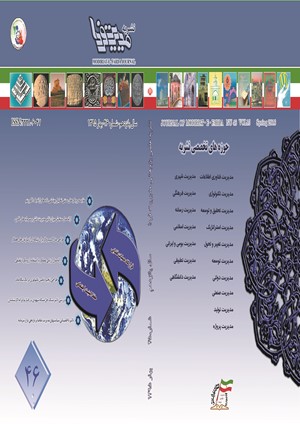طراحی مدل کسب و کار برای شبکهای از سازمانهای همکار
محورهای موضوعی : مدیریت تحقیق و توسعهایمان صادق زاده 1 , علیرضا علی احمدی 2
1 - دانشگاه علم و صنعت
2 - دانشگاه علم و صنعت ایران
کلید واژه: شبکه مدل کسب و کار اقتصاد مقاومتی مدل کسب و کار شبکهای سازمانهای شبکهای همکاریهای بلندمدت.,
چکیده مقاله :
توسعه سازمانهای شبکهای معمولاً با تولیت یک بنگاه مرکزی (مادر) پی گرفته میشود، بدین منظور بنگاه مادر علاوه بر تعریف راهبرد، ماهیت و سازوکارهای شبکه باید با تبیین یک مدل کسبوکاری استراتژیهای خود را در سطح شبکه به اجرا درآورد اهمیت مدل کسبوکار در شبکه تا آنجا مهم است که بسیاری از صاحبنظران نظیر زوت و آمیت مدل کسبوکار را موتور استراتژیهای مبتنی بر شبکه میدانند. در پژوهش حاضر، با نگاه به موضوع شبکههای همکاری، اقدام به طراحی مدل کسبوکار سازمان مادر در شبکههای همکاری بهعنوان نماد شبکه شده است. در این راستا با بررسی ادبیات موضوع، مدل ارائهشده توسط استروالدر (2004) بهعنوان مدل پایه انتخاب گردید و پس از افزودن چندین فاکتور مستخرج از ادبیات در بخش الزامات طراحی و شکلگیری شبکهها، مدل کسب و کار شبکهای در سه لایه تحت عنوانهای «لایه اول-ستونهای اصلی مدل کسب و کار شبکهای»، «لایه دوم- بخش بندی ستونهای اصلی» و «لایه سوم- مصادیق» طراحی و طی روش دلفی و در سه دور مورد قضاوت خبرگان قرار گرفت. پس از تائید مدل نهایی توسط خبرگان بهمنظور اعتبارسنجی مدل پرسشنامهای جهت سنجش مدل طراحیشده در اختیار خبرگان دانشگاهی و مدیران دو شبکه همکاری قرار گرفت. که نتایج به کاربردی و عملیاتی بودن مدل تدوینشده صحه میگذارد.
Abstract The development of networked organizations usually done by a focal firm (the mother). For this purpose focal firm in addition to defining the strategy of the partner firms and the nature and mechanisms of the network must develop a business model strategy to be implemented at the network. Significance of business model in a network is important as many experts as Zott and Amit realize business model as an engine for network base strategy. In the present study, we look at the issue of collaboration networks business model designed , to reach the goal of this study we consider focal firm as a symbol of collaborative network then we design a business model for focal firm. In this regard, after the literature review, the model presented by Osterwalder (2004) (BMO) was chosen as the Meta model, after that we adding several factors extracted from the literature on design requirements and the formation of networks. Then the model in Delphi process was judged and developed by experts. After confirming the final model by experts to further validate we design questionnaires that given to Academic experts and managers who working in two network, the result of that questionnaires approved the applicability of the model
Brekke, K.A. Kverndokk, S. Nyborg, K. 2003. An economic model of moral motivation. Journal of Public Economics 87 (9-10), 1967–1983.
Cummings, Thomas G. And Christopher G. Worley (۲۰۰۱) Organization Development and Change. Cincinnati: Thomson leartning.• Daft, Richard L. (۲۰۰۱) Organization Design and Theory, ۷th edition. Cincinnati, Ohio: Thomson Learning.
DaSilva Carlos M. Peter Trkman, Business Model: What it is and What it is Not,2013,Long Range Planning, Forthcoming
Galbraith, Jay R. (۲۰۰۲) Designing Organizations: An Executive Guide to Strategy, Structure, and process. San Francisco, CA: Jossey – Bass
Gibson, James. lvancevich, John M. and James H. Donnelly (۲۰۰۲) Organizations; Behavior, Structure, processes, ۱۱th edition. Boston: lrwin/McGraw - Hill.
Mohr, Jakki (۲۰۰۱) Marketing of High - Technology products and lnnovations. Upper Saddle River, New Jersey: prentice - Hall.
Osterwalder, (2004). “THE BUSINESS MODEL ONTOLOGY A PROPOSITION IN A DESIGN SCIENCE APPROACH” PHD thesis, Lausane Universty.
Osterwalder, A. Pigneur, Y. & L.Tucci, C. (2005). Clarifying business models: origins, present, and future of the concept. Communications of the Association for Information Systems, 16, 1-25
Raymond, E. Miles. (2009) THE FUTURE. University of California, the Hass school of business.
Rechtin, Eberhardt (۲۰۰۰) System Architecting of Organizations. Florida, Boca Raton: CRC Press
Romero,D, Nathalie Galeano, 2Arturo Molina, j. (2013) VO BREEDING ENVIRONMENTS VALUE SYSTEMS, BUSINESS MODELS AND GOVERNANCE RULES. Boston-Dordrecht-London: Kluwer Academic Pub. 2004.
Zott C, Amit R. The fit between product market strategy and business model: Implications for firm performance. Strategic Management Journal 2008; 29: 1-26.
Zott, C. & Amit, R. (2002). Measuring the performance implications of business model design: evidence from emerging growth public firms”,Fontainebleau, France. INSEAD Working Paper Series, 1-48.
Zott, C. & Amit, R. (2009). “The Business Model as the Engine of Network-Based Strategies”,Fontainebleau.
رحمیان، ح. (1390). طراحی و توسعه سازمانهای شبکهای. مجله مدیر ساز، سال ششم


